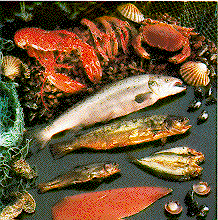 Prince George's County
Prince George's County Celebrates 300 years of history 1696-1996
 Prince George's County
Prince George's County
Celebrates 300
years of history 1696-1996

If you think about the food the Native Americans of Prince George's County might have eaten you probably think of wild animals and maize. Of course you would include crabs, clams, and many kinds of fish. But they did not limit their diet to these obvious items. Deer were a major part of their lives, not only for food but for clothing and tools fashioned from bone.
The early colonists ate a variety of animals: cattle, swine, chickens, deer, raccoons, squirrels, opossums, quails, turkeys, Canada geese, canvasback, mallard, redhead ducks, teals, loons, coots and double-crested cormorants. The bountiful waters provided many types of seafood, some of which we no longer find here today.
Until the use of freezers most of the butchering of hogs was done in the fall. The temperature was important, so it had to be on a cold day. The actual slaughter took place early in the day. The next step was the scraping off of the hair after the hog was sloshed in a barrel of very hot water. Real skills were required to clean out and actually butcher the meat. Scraps were used for sausage. Every woman had her own special recipe with just the right amount of sage to be used.
Winter vegetables were an important part of the diet. They could be harvested after frost and cooked with a bit of salted ham or fatback for a tasty meal. Today we often call them "greens" and some consider them "soul food", but they were an important part of the diet of many people of limited means. Many times cabbage was made into sauerkraut in a large crock.
The use of food was dependent upon the season until preservation by canning came into practice. By about the middle of the nineteenth century it became possible and reasonable to can food. The wide variety of fruits and vegetables grown here was a definite asset. The canning of food in glass jars was a summer activity in most Prince George's County kitchens. Refrigeration was not well developed until the 1930's, and then it required electricity or gas. The huckster sold fresh produce and sometimes ice. The ice houses found in several Prince George's communities were thriving businesses.
As the county became more populated and technology became more commonplace the availability and preparation of food changed drastically. Frozen foods have replaced most canning, even though some is still done in many kitchens. We eat in restaurants more than ever before, yet there are remnants of our past in what we eat today. Maryland is well known for its fried chicken and seafood. You can buy empanadas, chutney, "chittlins", duck, fish, mangos, fatback, and rockfish in our stores today. We have a very rich heritage, not only in history, but in the foods we grow and eat.
Some of the highlights of the county's culinary heritage are captured in a limited edition Tricentennial Cookbook. A member of the Tricentennial Celebration Committee and long-time county resident, Dorothy Rainwater, compiled the text which features 300 cherished family recipes from residents past and present.
The following is just one of many wonderful recipes found in the Tricentennial Cookbook. Thaddeus Frey graciously submitted this traditional recipe, which is from a handwritten cookbook dated June 18, 1781.
Take 12 ears of corn, grate them. Add 1 quart of rich milk, stir into the milk a quarter of a pound of melted butter, white sugar to make a little sweet, 4 eggs well beaten. Last, the grated corn; season with pepper and salt. Put the mixture in a dish and bake brown. (About 1 hour at 325 F.)
The 114-page, spiral-bound book also includes brief historical passages as well as pictures and descriptions of some of the county's historic structures. On sale through the Tricentennial Celebration Office for $10 (plus $2.50 shipping), the cookbook literally provides a way to get a "taste" of history.
For more information or to order your own Tricentennial Cookbook, contact the Tricentennial Celebration Office at (301)322-1996.
 Prince
George's
Tricentennial Home page.
Prince
George's
Tricentennial Home page.